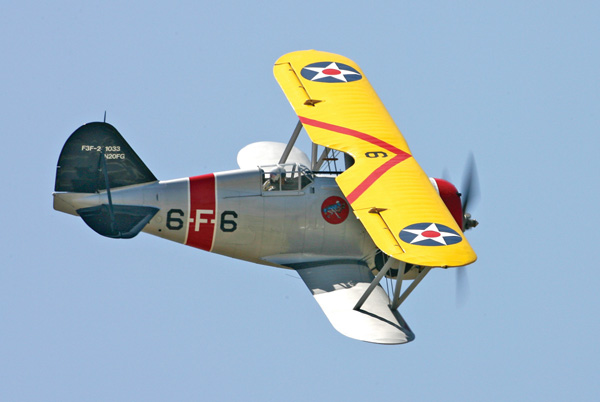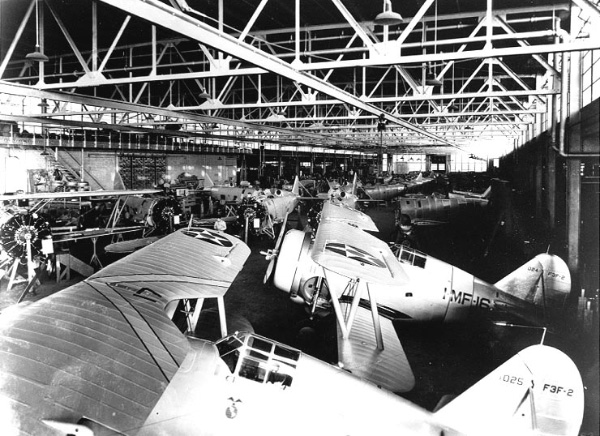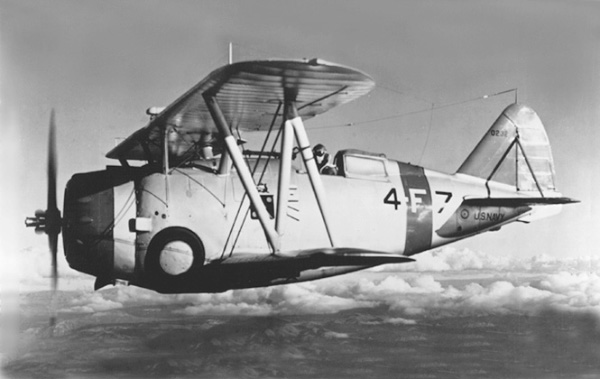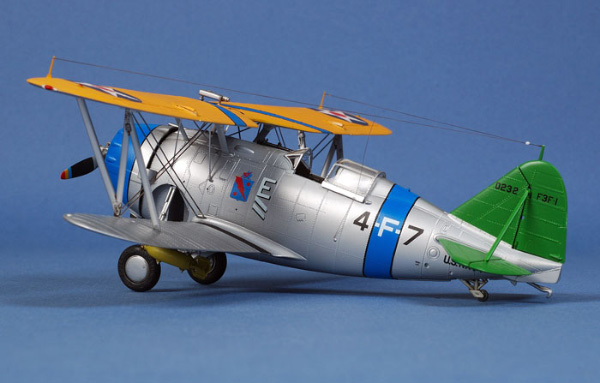
|
 |
Grumman F3F |
 |
 |
 |
 |
 |
|---|---|---|---|---|---|---|---|
 |
 |
 |
 |
 |
|||
 |
||
|
The Grumman F3F was an improved version of the F2F, and was the last biplane fighter that the US Navy put into service. The wing span was increased by 3 ft. 6 inches and the tail section was slightly enlarged. Ordered on October 15, 1934, the X3F-1 prototype was in fact the last F2F-1 series aircraft that had undergone modifications.1 The F3F was much easier to handle and more maneuverable than its predecessor. However, during flight testing, the airplane crashed, killing the test pilot, Jimmy Collins. On March 20, 1935, Collins was performing a series of ten test dives, to test the limits of the aircraft. While the first nine dives were completed successfully, on the tenth dive (from 18,000 feet), the wings and engine separated from the aircraft, putting the fuselage into a flat spin.2 An accelerometer had recorded that Collins had pulled 14 Gs during the dive.3 |
| A second prototype also crashed on May 17, 1935, after the test pilot, Lee Gehlbach, put the airplane into a ten-turn, right-hand spin at the US Naval Air Station at Anacostia.4 However, Gehlbach was able to bail out in time. A third prototype was ordered on June 20, 1935, (being built from undamaged components from its predecessor), with modifications to overcome problems encountered during spins. New trials began July 10, 1935 and the test flights went well enough for the aircraft to be put into production.5 |

F3F-2 fighters at the Grumman factory, February 1938. In August 1935, the US navy placed a production order for fifty-four F3F-1s, with the first to be delivered in 1936 to Squadrons VF-5B (USS Ranger), and VF-6B (USS Saratoga), with whom they continued to serve until 1940. One XF3F-2 was followed by eighty-one production aircraft, making the F3F-2 was the most satisfactory single-place fighter developed for the US Navy to date. This model served with VF-6 (USS Enterprise) and with US Marine Corps Squadrons, VMF-1 and VMF-2. The F3F-1 was powered by a 650 hp Pratt & Whitney Twin Wasp Junior R-1535-84, 14-cylinder, twin-row, radial engine, while the F3F-2 and F3F-3 were powered with by a 950 hp Wright Cyclone R-1820-22, 9-cylinder, single-row, radial engine, resulting in an increased diameter of the engine cowling.6 Originally, both engines had approximately the same horsepower, but despite the larger diameter of the Cyclone engine, carrier take-off was faster and the climb-rate was higher due to the lower weight of the engine.7 The final production model was the F3F-3, which was fitted with various propellers, split landing-flaps, modified cowling, and other devices intended to improve overall performance. Twenty-seven F3F-3s were delivered in 1938-39, which brought the overall production of F3F series aircraft to one hundred and sixty-four aircraft.8 Most of the F3F-3s went to VF-5 (USS Yorktown) or VF-7 (USS Wasp). By 1939, all US Navy and Marines Corps fighter squadrons were equipped with F2F or F3F series aircraft, and were not withdrawn from service until 1941. Afterwards they were relegated to training duties until November, 1943.9

A Grumman F3F-1 in flight with a Twin Wasp Junior R-1535 engine.

A scale model of the Grumman F3F-1 above. |
| Specifications: | |||
|---|---|---|---|
| Grumman F3F-1 | Grumman F3F-2 | Grumman F3F-3 | |
| Dimensions: | |||
| Wing span: | 32 ft 0 in (9.75 m) | 32 ft 0 in (9.75 m) | 32 ft 0 in (9.75 m) |
| Length: | 23 ft 0 in (7.01 m) | 23 ft 1.5 in (7.03 m) | 23 ft 1.5 in (7.03 m) |
| Height: | 10 ft 6 in (3.20 m) | 10 ft 9 in (3.27 m) | 10 ft 9 in (3.27 m) |
| Weights: | |||
| Empty: | 2,876 lb (1,305 kg) | 3,258 lb (1,478 kg) | 3,276 lb (1,486 kg) |
| Max T/O: | 4,403 lb (1,997 kg) | 4,750 lb (2,155 kg) | 4,795 lb (2,175 kg) |
| Performance: | |||
| Maximum Speed: | 231 mph (372 km/h) at 7,500 ft (2,286 m) |
256 mph (412 km/h) at 17,500 ft (5,258 m) |
263 mph (423 km/h) at 15,200 ft (4,633 m) |
| Service Ceiling: | 27,500 ft (8,382 m) | 30,300 ft (9,205 m) | 30,000 ft (9,144 m) |
| Range: | 885 miles (1,424 km) | 885 miles (1,424 km) | 980 miles (1,577 km) |
| Powerplant: | 1 Pratt & Whitney Twin Wasp Jr. R-1535-84 650 hp (485 kw) twin row, 14-cylinder, radial piston, air-cooled engine. |
One Wright Cyclone R-1820-22, 950 hp (708 kw) single row, 9-cylinder, radial piston, air-cooled engine. |
One Wright Cyclone R-1820-22, 950 hp (708 kw) single row, 9-cylinder, radial piston, air-cooled engine. |
| Armament: | One 0.50 caliber mg and one 0.30 caliber mg, 200 lb (91 kg) bomb. |
One 0.50 caliber mg and one 0.30 caliber mg, 200 lb (91 kg) bomb. |
One 0.50 caliber mg and one 0.30 caliber mg, 200 lb (91 kg) bomb. |
Endnotes:
|
1. Enzo Angelucci and Peter Bowers. The American Fighter. (Sparkford, Nr. Yeovil Somerset: Haynes Publishing Group, 1987.) 220. 2. Lt. Cdr. Benton Reames, U.S.N. Aircraft In Profile, Volume 4. The Grumman F3F Series. (Surrey, England; Profile Publications Ltd., 1968.) 3. 3. Richard Thruelsen. The Grumman Story. (New York: Praeger Publishers, 1976.) 85. 4. Lt. Cdr. Benton Reames, U.S.N. 3. 5. Enzo Angelucci and Peter Bowers. 220. 6. Gordon Swanborough and Peter Bowers. United States Aircraft since 1911. (Annapolis, Maryland: Naval Institute Press, 1990.) 217. 7. Herschel Smith. A History of Aircraft Piston Engines. Manhattan, Kansas: Sunflower University Press, 1993. 118-119. 8. Kenneth Munson. Fighters Between the Wars, 1919-39. (New York: The Macmillan Company, 1960.) 138. 9. Lt. Cdr. Benton Reames, U.S.N. 5. |
©Larry Dwyer. The Aviation History On-Line Museum. All rights reserved.
Created February 22, 2010. Updated April 27, 2021.